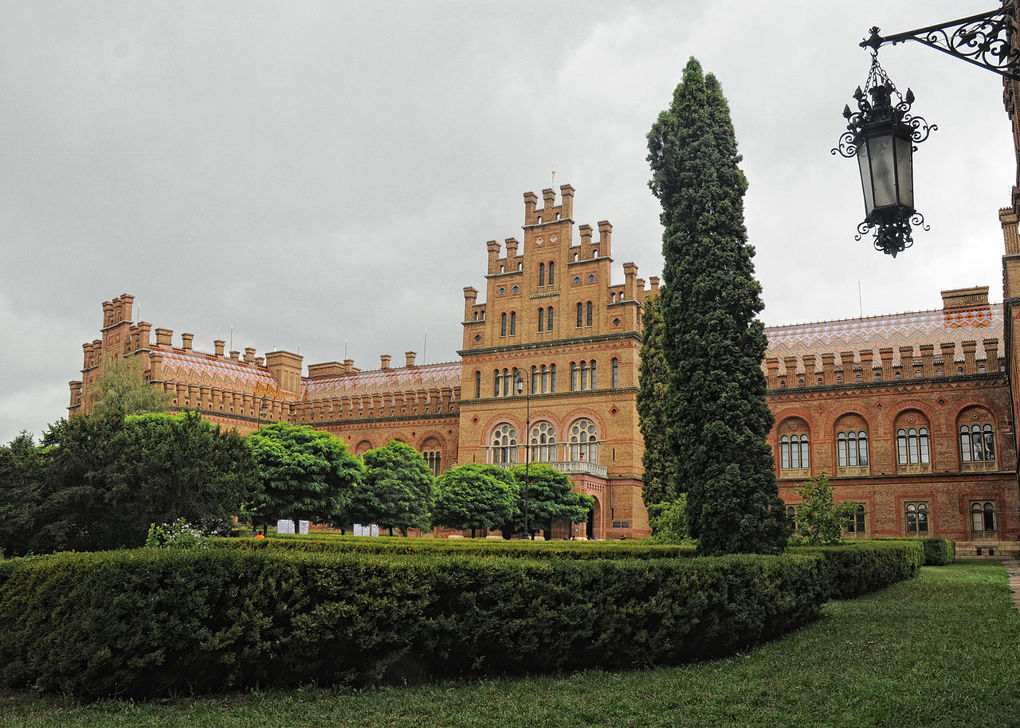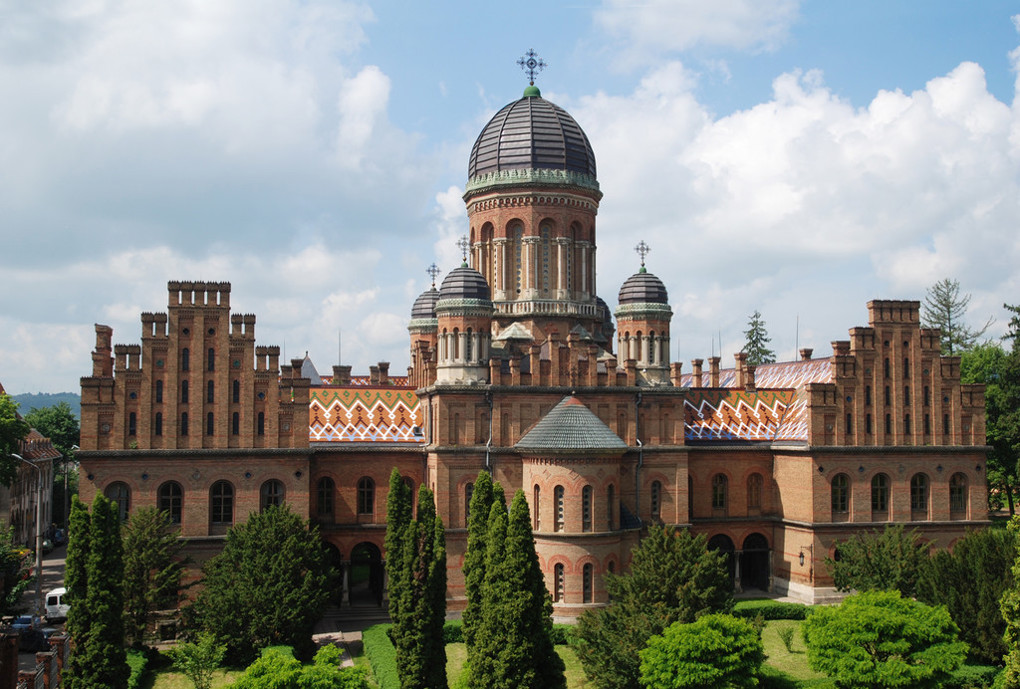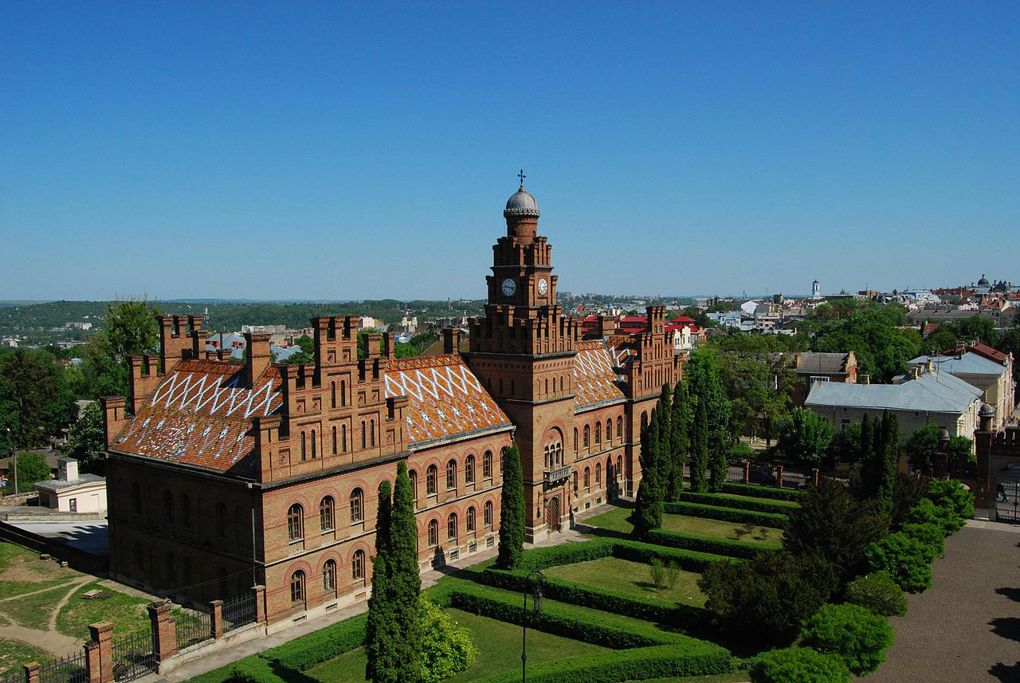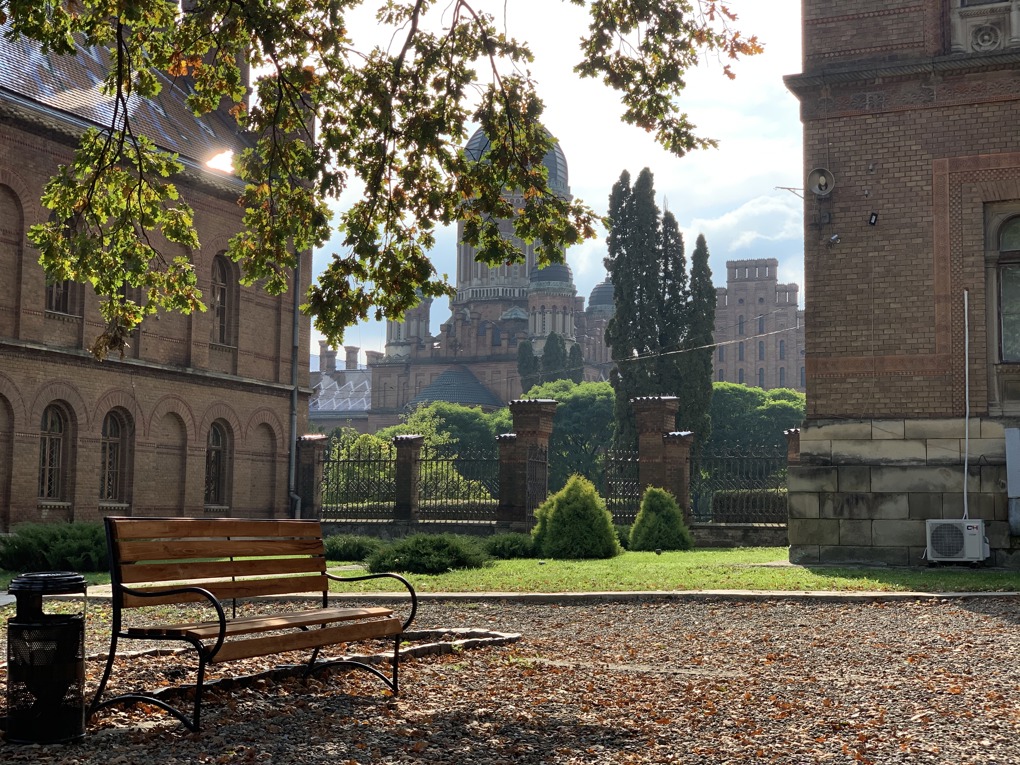
The Metropolitan Building
The Metropolitan Building, which forms the main visual axis of the architectural ensemble, has been an architectural monument of national importance (register no. 778/1) since August 24, 1963. Built at the end of the main court of honour (cour d'honneur) alley, the palace of the Bukovyna Metropolitans dominates the entire complex. The main rooms of the palace include a large lobby with massive columns on the top floor, and the Marble, Red, Green and Blue Halls on the second. Corridors lined with marble mosaics, with dome-shaped ceilings, impress with their beauty.
In March 1944, the Romanian-Nazi occupiers, who were retreating under the blows of the Red Army, caused a fire that almost completely destroyed the masterpiece Synod Hall (Marble Hall). Damages were calculated at a huge amount – more than 25 million rubles, and the loss of individual architectural elements and old prints from the metropolitan library cannot be estimated. Restoration works were carried out here twice with the participation of Kyiv, Lviv and local masters under the general direction of architect Mykhailo Shevchenko.
The Marble Hall
The Marble Hall (Synod Hall), made of white and black marble, has always impressed with its grandeur. A feature of the interior are side colonnades and arcades, which form a two-level gallery.
In the tympanums of the eleven arches and in the spaces between the columns, decorated with Bukovyna alabaster, the Austrian painter Professor Karl Jobst painted picturesque frescoes on religious and historical themes.
The Red Hall
To the left of the Marble Hall there is the Red Hall (Meeting Hall of the Holy Synod), the interior of which has been preserved in its original form. The room resembles a wooden casket of extraordinary beauty. The walls are decorated with Chinese silk, the ceiling is decorated with an ornament reminiscent of a collection of Easter eggs, and the floor is covered with red beech, oak and green linden parquet. The huge Venetian mirrors are hanging on one of the walls of the Red Hall, which are created according to ancient technology – counting up to five layers of silver.
The Blue Hall
The Blue Hall is located to the right side of the Marble Hall. In the past, the Metropolitan's library was located here. Today there is a hall for receiving important guests. In this case, the name also fully corresponds to the colour of the walls of this room.
The Green Hall
Next to the Red Hall there is the Green Hall, the former office of the Metropolitan. The first changes in the interior took place in 1919, during the reign of Romania in the North Bukovyna. Since the second half of the 20th century, the office of the rector of CHNU has been located here.

The Seminary Building
The Seminary Building, located to the left of the Main Gate, has been an architectural monument of national importance (ref. No. 778/2) since August 24, 1963. The building is built in the shape of the Cyrillic letter "П", which, together with the Church of Three Saints and connecting galleries, form a square with an inner green courtyard. The temple in honour of the Three Holy Hierarchs – Basil the Great, Gregory the Theologian, and John Chrysostom – has been an architectural monument of national significance (order no. 778/3) since August 24, 1963.
The Church of Three Saints
The construction of the temple in honour of the Three Holy Hierarchs – Basil the Great, Gregory the Theologian, and John Chrysostom – began on April 19, 1867, when Bishop Yevhenii (Hakman) solemnly laid the cornerstone.
The construction of the entire architectural ensemble of the residence was actually completed with the construction of the church (1882). The working temple was served by theology students and their teachers-mentors.
During the Soviet period (1944-1991), the cult building was closed, and the premises were used as an ES EVM hall. At the same time, the university management managed to preserve the paintings and the iconostasis. Thanks to this, the monument has survived to our time in almost its original form.

Presbytery
The Monastery Building (other names — Guest Building, Presbytery), located to the right of the Main Gate, is an architectural monument of national importance (ref. No. 778/4) since August 24, 1963.
At different times, the Deacon's School, the eparchial museum, guest rooms, a candle factory, and monastic cells were located here. Now the Faculty of Geography of CHNU is located here.

The Commercial Yard
In 2021, the UNESCO monitoring commission investigated the state of the architectural ensemble of the Residence 10 years after its inclusion on the UNESCO World Heritage List. In this regard, the university faced a difficult task – to free the Yard from all university property within a year, and to create a modern tourist infrastructure area there.
Reconstruction progress
On June 11, in the Red Hall of CHNU, a presentation was held for the representatives of the supervisory board of CHNU of the architectural part of the project for the arrangement of tourist infrastructure on the territory of the Residence courtyard. At the beginning of the meeting, Rector Roman Petryshyn said that currently, due to the pandemic, the Ministry of Education and Science of Ukraine does not allocate funds for such projects, so all financial costs fall on the shoulders of the university. Therefore, the institution's management relies on the help of the members of the recently formed supervisory board, which includes Chernivtsi businessmen and politicians.
After the first presentation and agreement of the draft project at the Rector's office in May, the rector published the document on his personal Facebook page for mass discussion. Thus, after tracking and monitoring all wishes and comments of the public, appropriate amendments were made to the project and submitted for review by those responsible for the reconstruction.
After the words, we got down to business – the specified documentation was approved by the Ministry of Culture and Information Policy. A few weeks later, the university received permission to carry out preparatory work. Finally, after obtaining the necessary approvals and permits, practical actions began in mid-September.
Currently, it is too early to talk about the final end of the main stage. However, with joint efforts, on June 28, 2022, all employees and residents of Chernivtsi celebrated with dignity the 10th anniversary of the inclusion of the Residence of the Metropolitans of Bukovina and Dalmatia in the most prestigious list of humanity – the UNESCO World Heritage List.